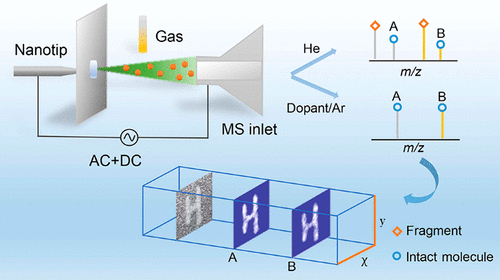当前位置:
X-MOL 学术
›
Anal. Chem.
›
论文详情
Our official English website, www.x-mol.net, welcomes your feedback! (Note: you will need to create a separate account there.)
Doped Argon Surface Desorption Dielectric-Barrier Discharge Ionization Mass Spectrometry for Fragile Compounds
Analytical Chemistry ( IF 7.4 ) Pub Date : 2018-07-03 00:00:00 , DOI: 10.1021/acs.analchem.8b01304 Hong Zhang 1 , Jing He 2 , Lina Qiao 1 , Kai Yu 2 , Na Li 2 , Hong You 1, 2 , Jie Jiang 2
Analytical Chemistry ( IF 7.4 ) Pub Date : 2018-07-03 00:00:00 , DOI: 10.1021/acs.analchem.8b01304 Hong Zhang 1 , Jing He 2 , Lina Qiao 1 , Kai Yu 2 , Na Li 2 , Hong You 1, 2 , Jie Jiang 2
Affiliation

|
Argon surface desorption dielectric-barrier discharge ionization (Ar-SDDBDI) in conjunction with dopants was reported for rapid and sensitive determining of fragile compounds. In dopant/Ar-SDDBDI, analytes are ionized primarily through proton transfer with dopant ions, which are formed in Ar plasma. Different from He, dopant/Ar-SDDBDI generates low energetic ions, and therefore, fragmentation is suppressed. It thus significantly simplifies the mass spectra and the assignment of one peak. Dopants ranging from organic solvents to gaseous materials were systematically studied. The application of dopant/Ar-SDDBDI was demonstrated by analysis of multiple compounds, including antibiotics, amino acids, fatty acids, hormones, pharmaceuticals, and peptides. Rapid profiling of chemicals in such complex matrixes including mixtures and drug tablets was also tested. Positive and negative mass spectra with little to no fragmentation for compounds in the pure state and as mixtures were readily achieved. Limits of detection (S/N = 3) were determined to be 0.60 and 0.36 pmol, respectively, for the analysis of l-alanine and metronidazole. Furthermore, the demonstration applications also included imaging of an “H” character under ambient conditions. These results indicate that the technique by combining of Ar-SDDBDI with dopants exhibits high sensitivity, high spatial resolution, and a very low degree of fragmentation, which render it a potential tool for fragile compound analysis in mass spectrometry imaging.
中文翻译:

易碎化合物的掺杂氩表面解吸介电阻挡放电电离质谱
据报道,氩表面解吸介电-势垒放电电离(Ar-SDDBDI)与掺杂剂一起用于快速,灵敏地确定易碎化合物。在掺杂剂/ Ar-SDDBDI中,分析物主要通过质子转移与在Ar等离子体中形成的掺杂剂离子电离。与He不同,掺杂剂/ Ar-SDDBDI产生低能离子,因此抑制了碎裂。因此,它极大地简化了质谱图和一个峰的分配。从有机溶剂到气态材料的掺杂剂得到了系统的研究。通过分析多种化合物(包括抗生素,氨基酸,脂肪酸,激素,药物和肽)证明了掺杂剂/ Ar-SDDBDI的应用。还测试了此类复杂基质(包括混合物和药片)中化学物质的快速分析。对于纯态化合物和混合物,几乎可以实现零碎或无碎裂的正质谱和负质谱。检测限(S / N = 3)分别为0.60和0.36 pmol,用于分析1-丙氨酸和甲硝唑。此外,演示应用还包括在环境条件下对“ H”字符进行成像。这些结果表明,将Ar-SDDBDI与掺杂剂结合使用的技术显示出高灵敏度,高空间分辨率和非常低的碎裂度,这使其成为质谱成像中易碎化合物分析的潜在工具。
更新日期:2018-07-03
中文翻译:

易碎化合物的掺杂氩表面解吸介电阻挡放电电离质谱
据报道,氩表面解吸介电-势垒放电电离(Ar-SDDBDI)与掺杂剂一起用于快速,灵敏地确定易碎化合物。在掺杂剂/ Ar-SDDBDI中,分析物主要通过质子转移与在Ar等离子体中形成的掺杂剂离子电离。与He不同,掺杂剂/ Ar-SDDBDI产生低能离子,因此抑制了碎裂。因此,它极大地简化了质谱图和一个峰的分配。从有机溶剂到气态材料的掺杂剂得到了系统的研究。通过分析多种化合物(包括抗生素,氨基酸,脂肪酸,激素,药物和肽)证明了掺杂剂/ Ar-SDDBDI的应用。还测试了此类复杂基质(包括混合物和药片)中化学物质的快速分析。对于纯态化合物和混合物,几乎可以实现零碎或无碎裂的正质谱和负质谱。检测限(S / N = 3)分别为0.60和0.36 pmol,用于分析1-丙氨酸和甲硝唑。此外,演示应用还包括在环境条件下对“ H”字符进行成像。这些结果表明,将Ar-SDDBDI与掺杂剂结合使用的技术显示出高灵敏度,高空间分辨率和非常低的碎裂度,这使其成为质谱成像中易碎化合物分析的潜在工具。


























 京公网安备 11010802027423号
京公网安备 11010802027423号